This was published 7 months ago
After two decades as lord mayor, does Clover Moore deserve four more years?
Many voters feel it is time for Sydney’s longest-serving leader to move on, but they’re not sure whether there is a better candidate.
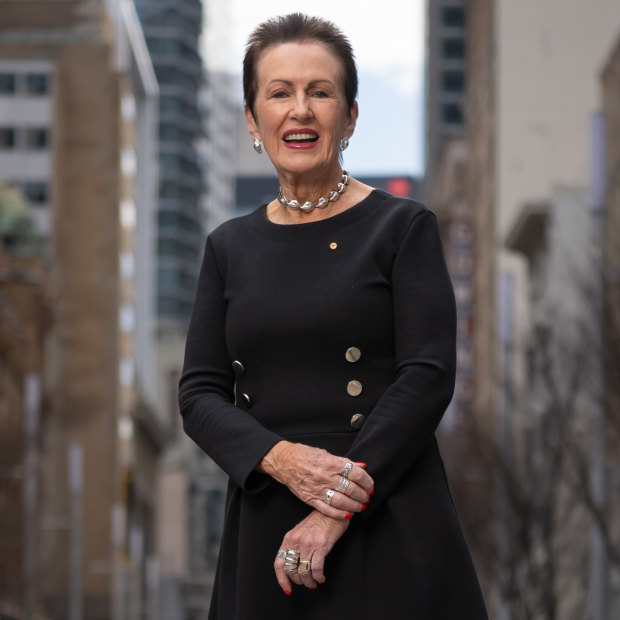
Sydney Lord Mayor Clover Moore, pictured on George Street.Credit: Wolter Peeters
Looking through the archives at some of the early coverage of Clover Moore’s tenure as lord mayor of Sydney, you notice how much the city has changed since she took over in 2004.
In the spring of that year, there were stories about the fight for control of Green Square. Back then, the corridor between Sydney CBD and the airport was an ex-industrial wasteland of car yards and warehouses. Today, it’s one of the densest residential parts of Australia – a radical urban renewal.
There was controversy over a $25 million swimming pool in Ultimo, the Ian Thorpe Aquatic Centre – one of two City of Sydney council-owned public pools opened by Moore, along with the sparkling Gunyama Park. She has upgraded four others.
Moore was advocating light rail on George Street, opposed by state Labor at the time, but now a reality that has transformed the city’s pedestrianised spine into a place people want to be.
And she has put the council on track to reach net zero emissions by 2035, ahead of schedule, with minimum energy ratings for new buildings set to achieve net zero energy use from 2026.
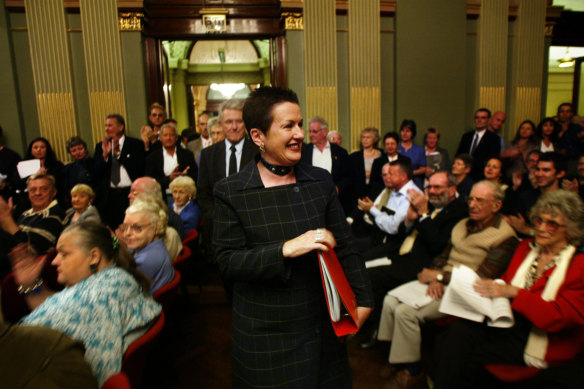
Clover Moore arriving at Sydney Town Hall for her first council meeting as Lord Mayor in April 2004.Credit: Wade Laube
Then there are the things that haven’t gone so well. Sydney’s struggles with nightlife, freedom and fun are well known. One story from 2004 casually begins by mentioning “the heart of Sydney’s 24-hour party scene at Taylor Square”. It is difficult to imagine anyone writing that now.
Oxford Street occupies a ghastly gulf between construction site and ghost town. Kings Cross is a shadow of its former self. Businesses are struggling; artists and creative types have left the city, which has become an incredibly expensive place to live.
Town Hall Square – a council pipedream that pre-dates Moore – is still a distant prospect, despite Moore having said in 2019 that it “will be realised over the next 10 years”. The CBD has changed considerably in her time, but it pales in comparison with the transformation of Melbourne’s skyline, mirroring that city’s rise to Australia’s largest and arguably most exciting capital.
These are only partly Moore’s problems. As mayor of central Sydney, many of her responsibilities are shared with the state government, for better or worse. It can be difficult to gauge exactly how much credit or blame to give Moore on any particular issue. But that’s the job she’s in.
What to think, then, of the 78-year-old who, after two decades in the role and 44 years in public life, is asking for four more years in power? What to make of her record as a leader, a city-shaper and, at the end of the day, a local councillor whose core jobs are rates, rubbish and roads? And crucially, should she be afforded one more term?
By any account, Moore has had a remarkable run. Including her early council career and long stint in state parliament, she has stood for office – successfully – 14 times. As one former staffer notes: “She has never lost an election. She has never even looked like losing one.”
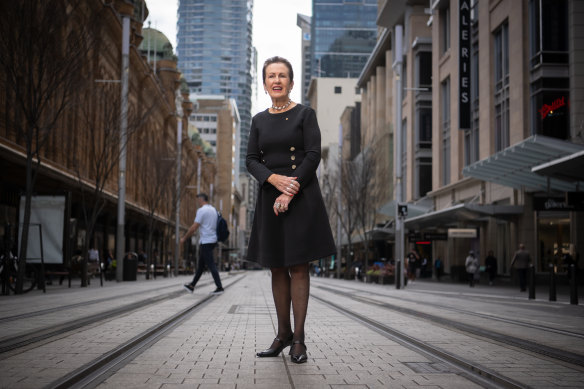
Lord Mayor Clover Moore this week.Credit: Wolter Peeters
Moore survived those 20 years in the mayoral chains untainted by scandal, at a time when several other Sydney councils have been investigated by the corruption watchdog, placed into administration or otherwise embarrassed.
That’s not to say she has been free from controversy. She is mocked for her obsession with cycleways, loathed by conservative media – most notably The Daily Telegraph and talkback radio – and was targeted unsuccessfully by the former Liberal state government. There was an ill-fated experiment with citywide tri-generation or “green energy” and the failed $22 million Cloud Arch vanity project.
But Moore kept winning a majority on the city council for her “independent team”.
The high point came in 2016, when she netted nearly 58 per cent of the primary vote for lord mayor, and her team won five of the nine other seats on the council.
The sheen came off in 2021 when her primary vote fell 15 percentage points. For some voters, there is a growing sense that it’s time for Moore to move on. If she retains the lord mayoralty next Saturday, there is a real chance she will lose her council majority and be forced to negotiate for the first time in 20 years.
The point of this piece is not so much to recap Moore’s many achievements but to lay out some of the future challenges facing the next council – and whether Moore is the best person to tackle them.
The village voice
The City of Sydney council occupies a unique place in NSW. It controls a powerhouse financial district as well as disparate neighbourhoods, from heritage-protected Glebe to the charming Potts Point, the modern high-rise Green Square and gentrifying Redfern.
It is by far the state’s richest council, controlling $15 billion in assets and collecting $850 million in operational income each year, with 21.2 per cent coming from rates paid by CBD businesses and 11.4 per cent from residents.
Moore came to office in 2004 spruiking a “city of villages”. She wanted to nurture the character of individual suburbs in the city, citing New York’s Greenwich Village and the Paris arrondissements. The great cities of the world, she said, were “amalgams of discrete communities”.
The tagline has stuck with Moore, for better or worse. Former prime minister Paul Keating ridiculed it in 2011 when they were at war over the development of Barangaroo. “She’s for low-rise,” he said. “She’s for sandal-wearing, muesli-chewing, bike-riding pedestrians without any idea of the metropolitan quality of the city.”
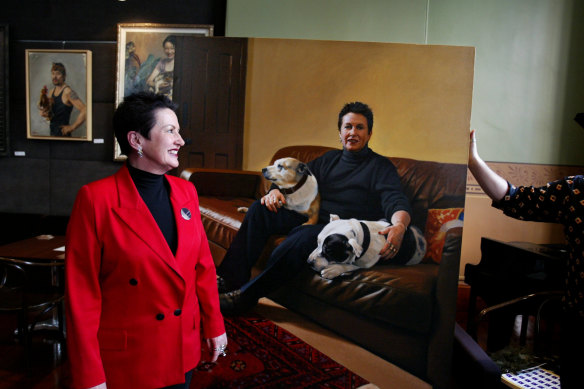
Lord Mayor Clover Moore in 2005 viewing a portrait of her and her dogs by artist Peter Smeeth.Credit: Tamara Dean
As recently as last month, developer lobbyist Tom Forrest lamented that the “city of villages” mindset contradicted Sydney’s role as the commercial centre for all of Sydney. Some feel that by taking a village approach, the notion of the big, bold, bustling city is lost.
But is that fair? Moore has always rejected accusations of NIMBYism. A 2004 profile piece in The Australian Financial Review, shortly after she was elected, reported: “Clover Moore is not anti-development. She’s anti-inappropriate development, a distinction she’s made ad nauseam, she says with a hint of exasperation.”
Moore went on to argue that politicians should not receive donations from property developers, a position that is now mainstream.
Indeed, it is impossible to label Moore a NIMBY without reckoning with the fact she has presided over – and at times led – one of Australia’s largest urban renewal projects at Green Square. As the Herald detailed in a feature last year, the corridor between Waterloo and Rosebery has been transformed from industrial dump to a high-density hub on its way to as many as 70,000 residents by 2036.
Recently, as the housing crisis has worsened, Moore even praised an old enemy, billionaire Meriton founder Harry Triguboff, for his 800-apartment development in Zetland, calling it a win for design excellence. And she slammed other councillors for opposing Meriton’s plan: “We are not going to address the housing crisis if we reject every planning proposal that comes across our desk.”
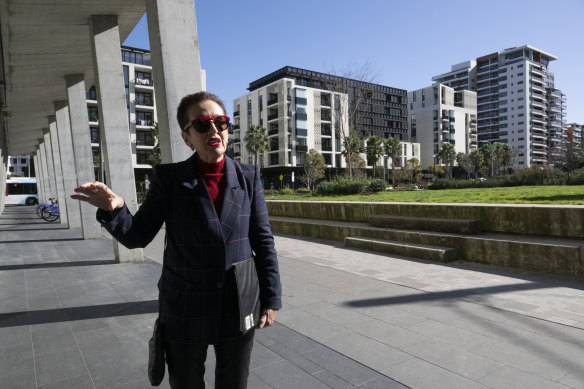
“We’ve done it despite the state, really, rather than because of it”: Lord Mayor Clover Moore in Green Square.Credit: Janie Barrett
Rob Stokes, the former Liberal minister for cities, worked reasonably closely with Moore over 10 years and varied portfolios and had a better relationship with her than most in his party. He believes her “city of villages” slogan was used – and misused – by political enemies.
“I don’t think she meant it in the way that Sydney wasn’t a global city,” Stokes says. “I don’t think you can fairly make that criticism. The statistics show that the city is more than pulling its weight in terms of new development.”
The CBD question
But there are divided views over how Moore has managed the city’s most important asset, the CBD. Primarily, the complaint is that residential development has been discouraged or blocked in favour of commercial buildings, and as a consequence, the city centre lacks a vibe.
A comparison to Melbourne is irresistible and stark. The population of Melbourne’s CBD exploded from 20,030 in 2011 to 37,321 just five years later and then to 42,366 in 2021. They are young (the median age is below 30), very likely to be students and they pay much less rent than their Sydney equivalents. Median rents in the Melbourne CBD fell below $400 a week during COVID.
In Sydney, it’s a massively different story. The population of the CBD, including Haymarket, The Rocks and Millers Point, rose from 22,760 in 2011 to 27,407 in 2016 and ticked up just slightly to 27,939 in 2021 (that may be suppressed by the pandemic, but so are Melbourne’s figures). If you exclude Haymarket and Millers Point, the CBD population fell to just 16,667 in 2021.
That means the Sydney CBD is still a place people visit for work or play, then go home. Moore has long said she wants more people to live in the city, but her council’s policies do not necessarily reflect that.
Last September, Premier Chris Minns accused Moore of “effectively outlaw[ing]” apartments in the city centre and said more residential development would help revive the CBD’s 24-hour economy and contribute to the state’s housing targets.
Moore – who famously bristles at criticism (more on that later) – said she was disappointed and surprised by the remarks and stressed the need for the CBD to “balance all needs”.
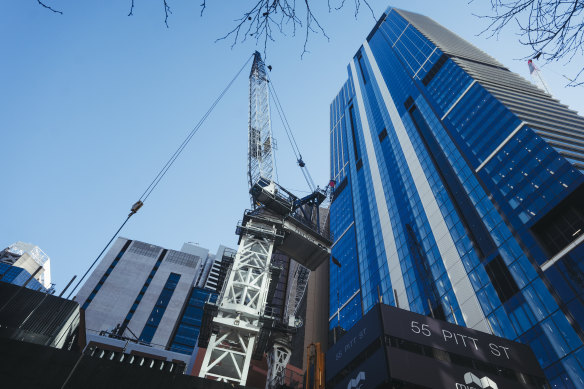
Moore has been criticised for favouring office development in the CBD over residential, but she argues maintaining commercial floor space is imperative.Credit: Dion Georgopoulos
Call it a threat, a warning or just plain notice, Minns said he was willing to intervene. “In the first instance, we’re going to give peace a chance and try and work our way through this, but if not, I’ve got obligations, as does the prime minister, to house people.”
The truth is residential development is not banned in the Sydney CBD: it is allowed under the SP5 Metropolitan Centre zoning. But it is rare. Some of that is policy-related, some is economic.
A 20-year Central Sydney Planning Strategy introduced in 2016 removed incentives for residential development. The city says this was a response to post-Olympics concerns that land prices being paid for trophy apartment towers “were pricing out workplace developments, despite the massive investment by the NSW government in transport infrastructure”.
This means proposals to increase the permitted height and floor space on a particular site cannot include residential buildings. If residential is to be built, it must be within existing zoned limits. Tom Forrest, the Urban Taskforce boss, says that’s a major roadblock.
“It damages the feasibility, and it basically becomes commercially more sensitive,” he says. “They know it effectively excludes residential development.”
At an election forum held this week by Business Sydney – which wants to double the population of Sydney’s CBD – Moore said 3200 homes had been built in the city centre in the past five years, and almost 5000 were “in the pipeline”. The CBD’s population was forecast to grow by 60 per cent in 20 years, she added, and “this high growth rate is comparable to urban renewal areas”.
This year, Moore introduced floor space incentives for build-to-rent and co-living housing in the CBD, which apply to both knock-down rebuilds and office conversions. She said build-to-rent was worth encouraging because it meant the flats were not owned by investors who could leave them empty for capital gain.
However, there was still a need to “preserve and bolster commercial, retail, tourism and cultural floor space to maintain Sydney’s status as a global city”, Moore said. This reflects her view that, broadly speaking, the current balance is right.
Almost every candidate at the Business Sydney forum agreed more people should live in the CBD. Indeed, it is an election in which the key candidates agree on the direction the city must take – more equitable, more vibrant – but have different ideas about how to get there. One of the fault lines is affordable housing policy.
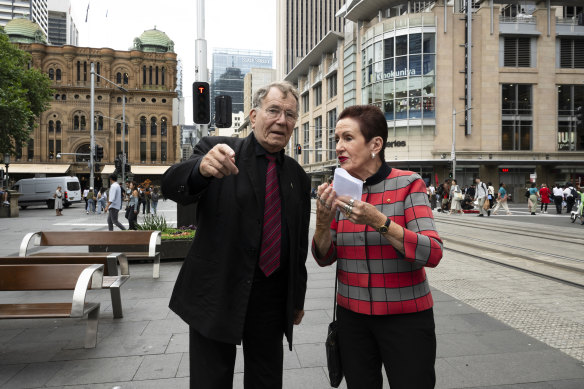
Clover Moore with architect and landscape designer Jan Gehl who drew up the plans for turning George Street in Sydney’s CBD into a car-free boulevard.Credit: Janie Barrett
Moore defends the council’s current settings, including a 1 to 3 per cent floor space or equivalent monetary contribution for all developments in the city. This helped build or plan 3323 affordable homes so far, she says, and will yield another 2000 by 2036, or 166 a year.
This is far more than any other council, but Moore’s main rivals are demanding greater ambition. Sylvie Ellsmore of the Greens wants the contribution rate increased as high as 30 per cent; she and Labor’s Zann Maxwell have pledged to take hundreds of millions from the council’s reserves to buy properties off the market and turn them into affordable rental homes; independent Yvonne Weldon wants to double the size of the council’s Affordable and Diverse Housing Fund; the Liberals’ Lyndon Gannon has rejected any new taxes, but wants to work with the state government on major renewal of Woolloomooloo.
The ideas-fest is good for democracy, but Moore is unpersuaded, dismissing them as pre-election thought bubbles. “Some councillors want us to liquidate assets and abandon our 10-year capital works program to buy 400 homes on the open market,” she said. “It’s shortsighted and won’t solve the housing crisis, but it will undermine our ability to deliver essential services or worse, send us bankrupt as occurred in the ’90s.”
In May, when she announced her re-election bid, Moore said overall the CBD was better than when she inherited it, thanks to the light rail she counts among her achievements.
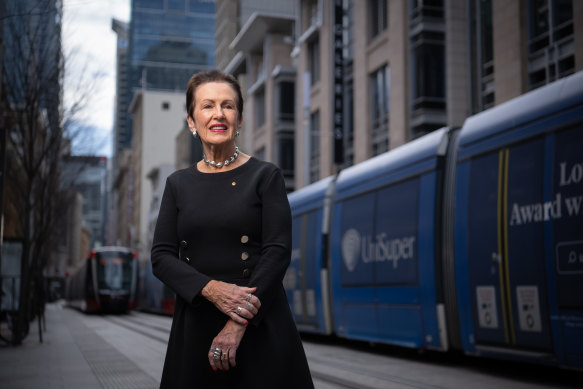
Moore counts the light rail among her achievements.Credit: Wolter Peeters
“[It’s] much more lively now than it was 20 years ago, you’d have to absolutely agree,” she told the Herald. “We do have more people living there. We do have more people spending time there and actually coming in and being there. In fact, Monica [Barone], my CEO, was at a recent function where [Merivale boss Justin] Hemmes was saying the city has never been busier; it’s absolutely buzzing.”
The 9pm city
Hemmes’ mega-precinct around the Ivy is certainly going gangbusters. Aided by the light rail and pedestrianisation of George Street, it has become the veritable focal point of entertainment in the CBD, presenting not just “Australia’s biggest weekly party” at Ivy Thursdays but a nightly rejoinder to the claim you can’t get a meal in Sydney after 10pm.
A couple of blocks away, the so-called YCK precinct (York, Clarence and Kent) is blossoming into a buzzing nightlife destination with a network of small bars, including rooftops and basements, new restaurants, laneways and the Machine Hall, a cool space for gigs and events. And the south end of the city, around Thai Town, always has life in it.
However, it’s not as rosy everywhere.
Oxford Street is close to Clover Moore’s heart. When she revealed she would seek an unprecedented sixth term, it was one of the first things she mentioned, acknowledging its struggles but insisting its best days were ahead.
More broadly, Moore’s commitment to the LGBTQ community cannot be questioned. She has been involved in the Sydney Gay and Lesbian Mardi Gras since 1986 – first as a judge, then as a marcher – before it was politically popular or even palatable.
But her tenure as lord mayor has coincided with difficult days for Sydney’s LGBTQ strip. She was elected just as the massive Westfield Bondi Junction opened, blamed for sucking the boutiques out of Oxford Street and the ladies who lunch out of Double Bay. “Wither Oxford Street” articles began appearing as early as 2005, and by August of the following year it was being described as “tatty”, “shabby” and “just awful”.
Since then, the strip has had ups and downs. Its present malaise is significant: battered by 10 years of lockouts and then COVID-19 lockdowns, only to have three whole blocks taken out by a vital but disruptive redevelopment on land the council leased to AsheMorgan for 99 years. The cycleway, also under construction, has aggravated shopkeepers even further.
In June, Moore addressed an meeting of underwhelmed Oxford Street business owners. Seemingly oblivious to the anger in the room, she began by recounting initiatives her council had taken for the area, including the rainbow crossing, pride flags and vests affixed with pride logos for nightclub security guards, aimed at enhancing safety.
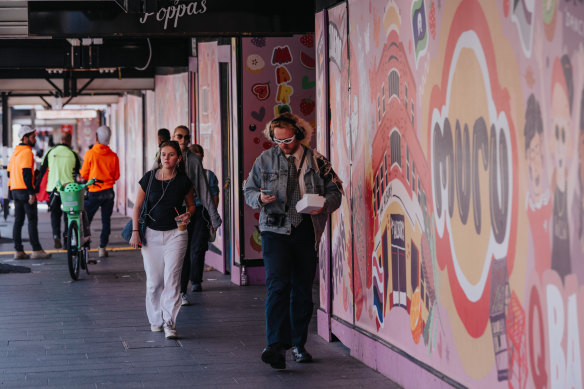
The AsheMorgan/TOGA redevelopment means three blocks on the north side of Oxford Street are currently boarded up.Credit: James Brickwood
She then valiantly defended the coming cycleway, insisting it would be good for businesses, despite murmurs and protests from the audience. Later, Moore returned to Town Hall for a Pride Month event and bemoaned: “I’ve been at the Oxford Hotel with a whole lot of unhappy business people not wanting to hear about all the fabulous things we’re doing in Oxford Street.”
There were few positive ideas or concrete plans aired that evening, either from the council or business owners. Turning Taylor Square and the area outside the courthouse into a piazza was mentioned – an idea that has been promoted since at least 2006. Some business owners worried tenants in the AsheMorgan/TOGA redevelopment would be too upmarket or outside the queer community. There were grumbles about delays caused by a change of builder.
Moore says the project is a catalyst for Oxford Street’s renewal, and the “stars are aligning” to that end. “I’m really disappointed when councillors or business people in Oxford Street run the street down when we’re really on the cusp of a renaissance for it,” she told the Herald.
“Some of the work is challenging because you’re in a city environment and people, we as humans, inherently don’t seem to like change until we experience it. If people can just have faith and let it happen,” she says, they will come to appreciate it.
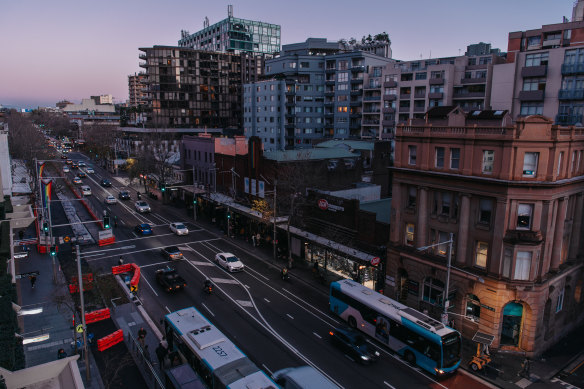
Oxford Street.Credit: James Brickwood
The strip has become Sydney’s closest thing to the old Kings Cross, home to a slew of LGBTQ and “straight” nightclubs. It is still busy late on Saturday nights, but the rest of the time, it needs help – much more than a bike lane and a new hotel. It is full of decrepit buildings, many of which are owned by landlords who don’t care if they sit empty – just as the city let its properties sit dormant for years.
‘They don’t care’
Oxford Street is far from alone in its malaise. Darlinghurst Road in Kings Cross has devolved from seedy to simply sad, with the old strip clubs shuttered and most shops vacant, except for the vape stores and fast food joints.
Brandon Martignago, who runs Dulcie’s cocktail bar on Darlinghurst Road and the Emerald Room cabaret bar on Victoria Street, has witnessed the decline first-hand. Having supported Moore for many years, he no longer believes she is best placed to fix the city’s problems.
“What Clover has done is set the city up for change, and that has now plateaued,” he says. “This is the perfect time for someone to come in and utilise everything she has worked hard to do.”
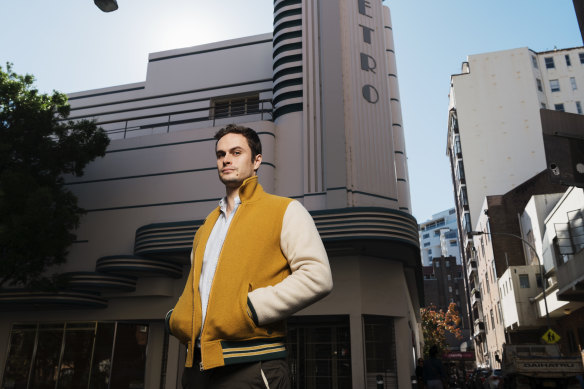
“We have a council who is apathetic until they are militant”: Business owner Brandon Martignago will change his vote.Credit: James Brickwood
Martignago also ran the Potts Point Partnership (for businesses) and interacted with the council constantly. In his experience, council managers are stuck in their old ways and holding back the city.
“They don’t want to go any further. It seems like everything is a bit too hard,” he says. “Clover is copping a lot of flak, but it’s really [the staff] that have their own intentions.”
The city council’s senior officeholders are nearly as entrenched or experienced as Moore. Chief executive Monica Barone has held her position since 2006, Graham Jahn was appointed planning director in 2009, and chief operating officer Kim Woodbury got the job in 2010.
One particular interaction has stuck with Martignago. He says he took Moore and another of her long-serving advisers, Larry Galbraith, to Kellett Street’s burgeoning food and beverage scene just behind Darlinghurst Road. It would be great, he said, if people could walk through the council-owned library and civic centre straight from Kings Cross train station to Kellett Street.
“Clover took it to Town Hall House,” he recalls. “They turned around and said the gradient is too different, so you would need an accessibility option, either a lift or a ramp, and it would cost too much money. They had no interest in doing it.
“This is the culture that I think has permeated. They are now so risk-averse and so unwilling to think of exciting things beyond the tried-and-true measures of bike paths and footpath widening. They don’t want to be provocative, they just want to be conservative and restrained and put on this facade that they’re doing all this stuff.”
Martignago accepts many of the problems he and his businesses are confronting – the decline in people going out at night and noise complaints from neighbours – result from far bigger societal changes over which Moore has no control: the lockouts, which were state government policy, the high cost of living, the changing demographics of the inner city as more people are priced out.
But he still says the council has been “completely hands-off”, with no interest in being involved in long-term planning for what to do with Kings Cross in the post-lockout era. But heaven forbid you break a rule or ignore a guideline.
“We have a council who is apathetic until they are militant,” Martignago says. “The role of a lord mayor and a council is to shape the city. They have all the data, they have the control, they liaise with the state. They are the people who can effect and make change, but they don’t care.”
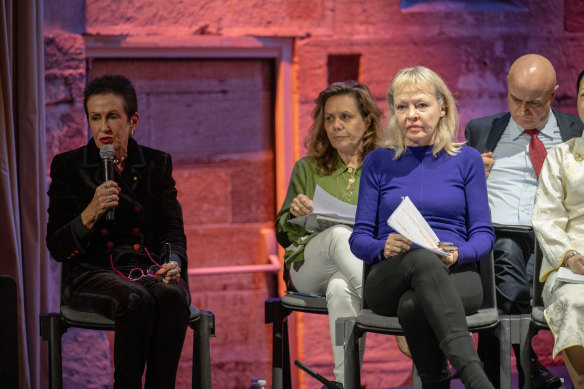
Clover Moore was heckled when she said Sydney’s small bars and laneways, pre-lockouts, were better than Melbourne’s.Credit: Wolter Peeters
The issue was recently exemplified by a council staff decision to cut back outdoor dining hours at the much-loved Old Fitz pub in Woolloomooloo, after inspectors found stray kegs on the footpath and two neighbours complained.
The punishment appeared out of proportion to the crime, and Moore – once made aware of the issue – swiftly intervened. Last week, the decision was formally reversed, and patrons can use the outdoor area until 10pm again.
Moore strongly defended council staff and their work. “Attracting and retaining the very best staff is a challenge in a globally competitive environment”, she told the Herald, and she was concerned about what would happen if they were swapped out for populism and “ever-changing whims”.
In this election campaign, Moore has been forced to reckon with the nightlife issue, especially by younger rivals. During a candidate forum at the National Art School, she was heckled for arguing that before 2014’s lockout laws, Sydney’s laneways and small bars were “better than Melbourne”. Other candidates instantly declared it proof Moore was out of touch. Her point is the policies are in place, and the fundamentals are strong – but that is not the lived experience of many operators.
As for solutions, Labor’s Zann Maxwell proposes using a state government policy to create five “special entertainment precincts” where rules are relaxed and later trading is encouraged. The precincts could include Oxford Street, Moore Park’s Entertainment Quarter, and the Hollywood Quarter in Surry Hills, he says.
Moore has long argued the City already does this, but she is awaiting a report on converting the council’s existing late-night trading areas to special entertainment precincts – with one caveat. “These precincts must be supported by public transport operating 24 hours a day,” she says.
Gripes and grievances
Whatever the city council’s significance to broader Sydney, we should also remember that it’s a local council with residents who want their basic services maintained. This caused Moore grief last year, when industrial action involving contractor Cleanaway led to rubbish piling up on the streets.
Some rivals still see it as a potent issue; Maxwell, for one, says he would investigate bringing bin collection back in-house, something Moore has dismissed as “incredibly costly and disruptive”.
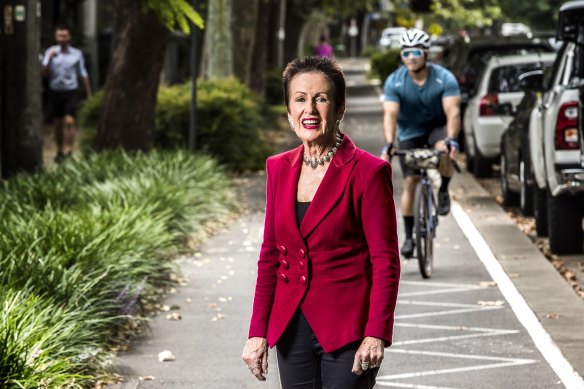
Clover Moore on the Bourke Street cycleway in Redfern, which opened in 2011, pictured ahead of the 2021 election campaign.Credit: Steven Siewert
The lord mayor’s long-standing support for bike paths is also back under the microscope, with the Oxford Street West cycleway and its planned extension through Paddington (a state government project supported by Moore) irking business owners and conservative columnists.
The outrage is at fever pitch, but it is not new. Moore has been opening bike lanes since 2009 (Kent Street), with her first two-way separated cycleway (Bourke Street) opening in 2011. It even features on the front cover of a 500-page glossy hardback book detailing the council’s projects from 2004 to 2020, called Creating a Liveable City. No cycleway appears to have had an electoral impact, and nor have attempts to portray Moore as an out-of-control greenie.
In one sense, Moore can only be described as a stoic, having withstood the critics for so long and without electoral consequence. But she can also be stubborn and sensitive to criticism. She is notoriously conservative and careful about what she says and does in public.
“She has got an incredible glass jaw,” says one former staffer. “If anyone says anything about her on Facebook or whatever, she is terribly precious.”
The city council maintains a healthy “correspondence team” to respond to emails, social media inquiries, complaints and letters to the chief executive or lord mayor, as well as a business concierge service. The unit employs 11.5 full-time positions and has an annual salary budget of $1.3 million.
Media is closely monitored. Staff recall being dragged into the office on New Year’s Day 2015 after the Herald reported NYE crowds had halved from the previous year’s estimate and called the event a “damp squib” (it was weeks after the horrific Lindt Cafe siege in Martin Place).
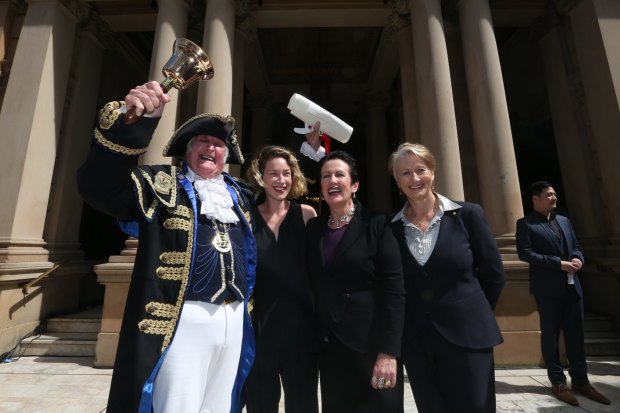
Pictured in 2016: Town crier Graham Keating, councillor Jess Miller, Lord Mayor Clover Moore and deputy mayor Kerryn Phelps.Credit: Louise Kennerley
In her memoir, Kerryn Phelps writes that during her nine months as Moore’s hand-picked deputy mayor, she was counselled on several occasions by Moore’s staff over comments she had made to journalists that were not sufficiently in line with the team message.
Phelps resigned to become an independent in June 2017, writing in Power of Balance that she had “had enough of the antics and the way I was being treated”.
Present-day rival Yvonne Weldon complained at a recent public forum: “Even her remaining fans know that Clover is inflexible, dogmatic, does not work collaboratively with her fellow councillors and will never admit when she is wrong.”
Whether Moore can be controlling or difficult to work with may not matter to voters. But where it does concern them is succession. Amid the Phelps falling-out, Moore said she was “very aware of succession in terms of [her] team”. But so far, no one has got a look-in.
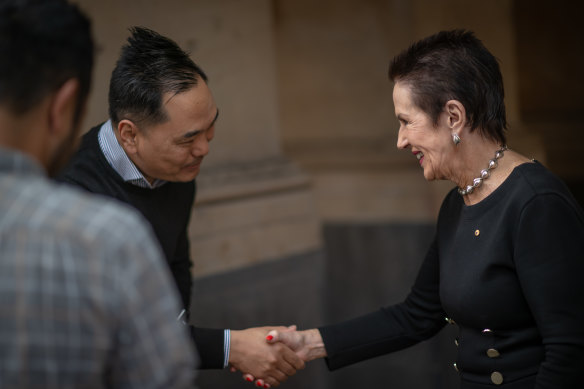
Clover Moore meets a constituent while posing for photographs with the Herald.Credit: Wolter Peeters
Jess Miller, who returns to the Clover Moore Independent Team in third place on the ticket, is a natural contender should Moore decide to retire. But former councillor Jess Scully, who quit last April citing inadequate maternity leave provisions, was once regarded in similar terms.
Many wonder whether Moore has any fresh ideas left. To that, she can point to her big new project: advocating for extending light rail along Broadway to Sydney University, and from Central to Green Square. It feels unlikely, given the state government’s finances, but it’s an idea.
In a recent Herald interview, when Moore was asked about her mistakes over the past 20 years, she raised eyebrows by remarking: “I don’t think I personally make mistakes because I’m careful about what I do.” But it was a large organisation made up of many human beings, she said, and things could go wrong.
Some observers and rivals feel a certain arrogance has crept into Town Hall. But the dynamic – the strong independent taking on the major parties and the tabloids – works for Moore politically. One of her main reasons for seeking a sixth term is to keep out the major parties, which she says would be bad for the city.
She now broadens that message to include rivals of all kinds. “I run a responsible city government, and I’m running for re-election because I don’t want to see our good work undone in the hands of the major parties, the inexperienced, or people whose short-term populism is more important to them than stable, effective government,” Moore says.
After 20 years in the role and 45 in public office, Moore was always going to be able to play the experience card against her challengers. The question is whether, at some point, that becomes as much a liability as an asset. At one candidate’s recent campaign event, a speaker observed that if Mikhail Gorbachev were still president of Russia, he would not have served as long as Moore.
On the other hand, no party or group is running a high-profile contender to take her on. Weldon, Gannon and Ellsmore have each served one term on council, while newbie Maxwell replaces long-serving councillor Linda Scott at the top of Labor’s ticket. There is no clear rival; last time, Moore commanded just over 40 per cent of the vote, Labor and the Liberals about 15 per cent each, and both Weldon and the Greens less than that. “Her opposition is scattered and disparate,” says election analyst Ben Raue.
Moore’s staunch ally and successor in state parliament, Alex Greenwich, says the political parties forget that voters know Moore delivers, and he condemned a preference deal that will see them recommend votes for each other ahead of Moore and her team. “Fortunately, every election the parties get reminded that Sydney voters are smarter than them,” Greenwich said.
Few expect Moore to lose the mayoralty, but many, including Raue, believe she will be forced into minority for the first time. “I think that’s more likely to be where things go,” he says.
After 20 years, a bit of negotiation may not be a bad thing.
Get the day’s breaking news, entertainment ideas and a long read to enjoy. Sign up to receive our Evening Edition newsletter.